"Volcanoes are monuments to Earth's origin, evidence that its primordial forces are still at work. During a volcanic eruption, we are reminded that our planet is an ever-changing environment whose basic processes are beyond human control. As much as we have altered the face of the Earth to suit our needs, we can only stand in awe before the power of an eruption."
Taken from the National Park page
 |
| Kilauea Overlook in Volcanoes NP |
I visited Volcanoes National Park about 5 years ago. As a travel agent we are sometimes sent on what is known as a FAM trip. The trip is to familiarize us with what there is to see and do, and places to stay in the area they have sent us. I was sent on a FAM trip to the big island of Hawaii. It was a dirty job, but someone had to do it. It was a week of seeing the sights of the island, spending time touring the different hotels there, and even relaxing and enjoying ourselves, all at company expense. Not a bad way to go. One of our days on the island we drove over to the other side of the island and toured Volcanoes National Park. It was a very informative day, and one I very much enjoyed. Now, my husband and I along with another couple, are planning a trip to the big island in January, so I decided to take another look at what there is to see and do at the park, which we are sure to visit again.
 |
| Steam vents at Steaming Bluff in Volcanoes NP |
The Kiluea Visitor Center should be your first stop when entering the park. The center features informative displays and has the movie "Born of Fire..Born of the Sea", which is shown on the hour throughout the day, starting at 9:00 a.m. and showing the last film at 4:00 p.m. One thing to remember when you go is that the park is located at 4000' elevation and the weather can change very quickly. You should be prepared for hot or cold and sunny or rainy. A warm, sunny day can change to cold and rain in a matter of minutes. So make sure you take along some warmer clothes to slip into if you need them.
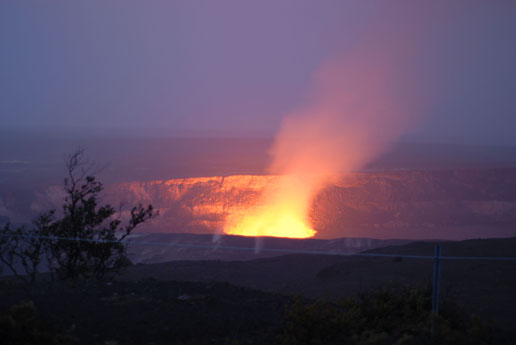 |
| View from Jaggar Museum Overlook |
The following is a recommendation from the National Park Page on things to do in the park:
| Holei Sea Arch at end of Chain of Craters Rd. |
If you have only one to three hours, explore the summit of Kīlauea volcano via the Crater Rim Drive; an 11-mile road that encircles the summit caldera, passes through desert, lush tropical rain forest, traverses the caldera floor, and provides access to well-marked scenic stops and short walks. (Note: Crater Rim Drive is closed between Jaggar Museum and the Chain of Craters Road junction due to volcanic activity in Halema'uma'u.)
Four to 5 Hour Visit?
If you have four to five hours, you may also explore the East Rift and coastal area of the Park via Chain of Craters Road. This road descends 3,700 feet in 20 miles and ends where lava flowed across the road in 2003. At the end of the road you will find the ocean and the Holei Sea Arch.
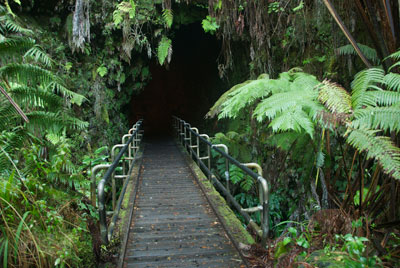 |
| Thurston Lava Tube, Volcanoes NP |
One of the stops on the Crater Rim Drive is a stop at the Thurston Lava Tube. I particularly remember walking through this tube when we visited. Just before you arrive at the tube the forest becomes increasingly lush. From the parking area it is a 20 minute, 1/3 mile walk through a tree fern forest. This is an excellent place to stop and listen to the birds. This lava tube was discovered in 1913 by Lorrin Thurston, a local newspaper publisher. At that time the roof of the tube was covered with lava stalactites, but those soon disappeared to souvenir collectors. As you walk through the tube consider that several hundred years ago a river of red lava rushed through. And that lava currently travels from Pu'u O'o to the ocean in a labyrinth of lava tubes much like the tube you are walking through. Watch your head in the tube - there are some spots with a low ceiling!
There are so many things you can do when visiting the park. There are hiking trails, including hiking out to where the active lava is flowing, but do so with caution and make sure you have good hiking shoes to protect your feet, and take water to drink. You can also bicycle the roads of the park. There are also many ranger led programs. If you want to spend more than a day in the park then there are campgrounds and lodging in the park, as well as in nearby Hilo.
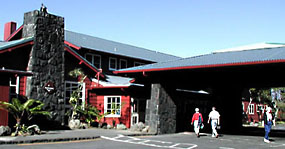 |
| Volcano House provides Lodging and a restaurant |
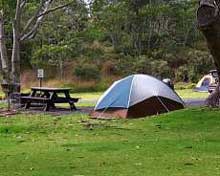 |
| Namakanipaio Campground |
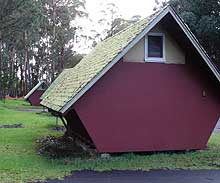 |
| Cabins at the Namakanipaio Campground. |

No comments:
Post a Comment